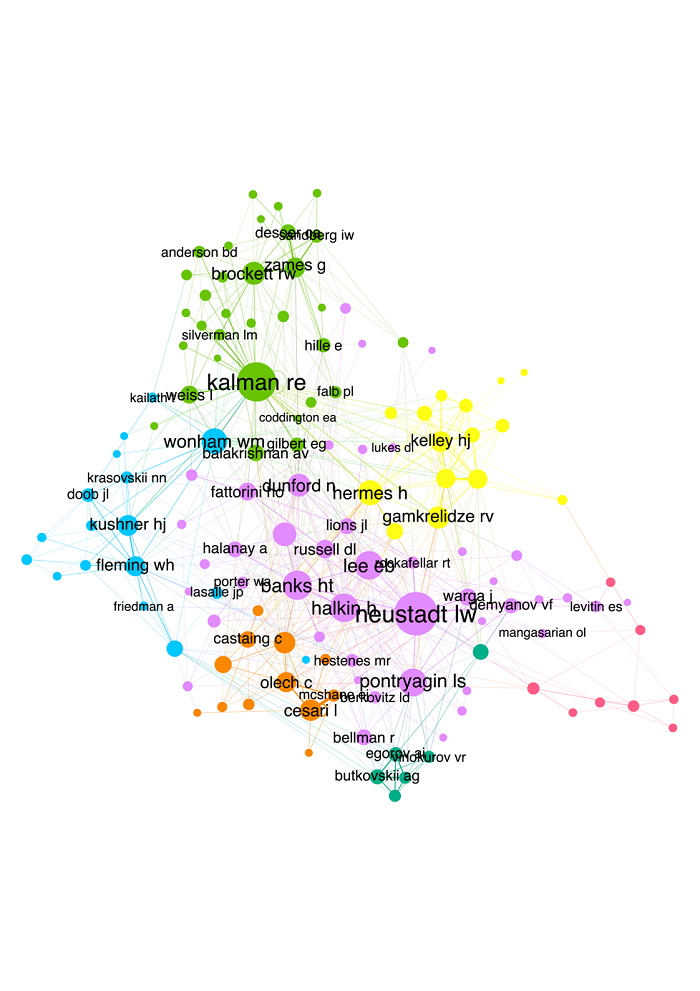
Received: September 20, 2020
Accepted: February 26, 2021
This article advocates the benefits of a sociological perspective for the philosophy of mathematical practice. Drawing from the literature of the sociology of sciences, it defends a community-centered approach of the study of mathematical practice and assesses the role of the notion of metamathematics in mathematical change and in stabilized mathematical practices. It relies on the case study of the emergence of geometric control theory at the beginning of the 1970s and of the citational practices associated to the community of control theory since the mid-1990s. The case study shows that the introduction of geometric tools in control theory at the end of the 1960s induced a change in the metamathematical views that control theorists had on their objects. It is then demonstrated how membership to the community of control theory shapes the production and the reception of the theorems of Stefan, Sussmann and Nagano. Interpreting the historical development and citational practices of this community through the perspective of metamathematics, this paper concludes by discussing the role of the orbit theorem in control theory, both as a cognitive label and as a social marker of membership to this community.
Keywords: Co-citation analysis, control theory, mathematical practice, metamathematics, scientific communities.
Aprovechando la literatura de la sociología de la ciencia, este artículo aboga por los beneficios de una perspectiva sociológica en la filosofía de la práctica matemática. Para ello, propone un enfoque de la práctica matemática que se fundamenta en la noción de comunidad matemática, al tiempo que evalúa el papel de la noción de metamatemática en el cambio matemático y en las prácticas matemáticas estabilizadas. Su punto de partida es un estudio de caso: la aparición de la teoría del control geométrico a principios de los años 70 y las prácticas de citación asociadas a la comunidad de la teoría del control desde mediados de los 90. En él se expone que la introducción de las herramientas geométricas en la teoría del control a finales de los años 60 condujo a un cambio en las opiniones metamatemáticas que los teóricos del control tenían de sus objetos. A continuación, se muestra cómo la pertenencia a la comunidad de la teoría del control da forma a la producción y recepción de los teoremas de Štefan, Sussmann y Nagano. Por último, la interpretación del desarrollo histórico y de las prácticas de citación de esta comunidad, a través de la perspectiva de la metamatemática, concluye con una discusión del papel del teorema de la órbita en la teoría del control, tanto como etiqueta que designa un determinado contenido cognitivo, como marcador social de pertenencia a esa comunidad.
Palabras clave: análisis de cocitación, teoría del control, práctica matemática, metamatemáticas, comunidades científicas.
To Robert Hermann (1931–2020)
Beginning in the second half of the 20th century, some philosophers of mathematics have advocated a more ‘practice oriented’ approach to their field and have developed what is now called the philosophy of mathematical practice. This intellectual movement argues that restricting philosophy of mathematics to foundationalism and logicism not only caricatures the production of mathematical knowledge, but also overlooks important philosophical questions that would benefit from being investigated through the study of praxis.
Attention to mathematical practice is a necessary condition for a renewal of the philosophy of mathematics. We are not simply proposing new topics for investigation but are also making the claim that these topics cannot effectively be addressed without extending the range of mathematical practice one needs to look at when engaged in this kind of philosophical work. Certain philosophical problems become salient only when the appropriate area of mathematics is taken into consideration (p. 2).
Although the epistemic stance that accepts mathematical practice as relevant to philosophical inquiries has its roots in the mid-twentieth century, the number of contributions has only flourished in the last twenty years. Indeed, the impressive outpouring of papers, monographs, conferences, and collective volumes, as well as the creation of the Association for the Philosophy of Mathematical Practice in 2009, affirm the position of the philosophy of mathematical practice as a legitimate subfield of the philosophy of mathematics.
However, although philosophers of mathematical practice advocate a philosophical approach that interacts with other disciplines, the integration of sociological concepts and methods has been scarce. This may be explained by the embryonic state of the sociology of mathematics, despite early works by sociologists
This article highlights how the philosophy of mathematical practice would benefit from a sociological perspective. For instance, sociological concepts such as scientific communities are of central importance for understanding collective mathematical practices. Based on the literature in the sociology of science, a community-centered approach to the study of mathematical practice will be advocated first. It will then be explained how this approach is particularly suited to outline the role of metamathematics, a philosophical concept used as placeholder for the opinions, views and positions which mathematicians maintain with respect to their practice (
In the first part of the case study, it is shown how that the introduction of geometric tools in control theory in the 1960s precipitated a change in the metamathematical perspective, resulting in the emergence and grow of a new practice. This mathematical community – later called ‘geometric control theory’ – has the particularity of merging elements from differential geometry and from applied mathematics to solve problems about systems of nonlinear differential equations. A founding element of this community is the so-called orbit theorem: although this label only appeared in the 1980s, it refers to a statement originally formulated – and proved independently – by control theorist
Mathematical research is a collective enterprise ranging from training under the supervision of a mentor, to writing and publishing papers as a professional mathematician. However, these institutional aspects are merely the tip of the iceberg, for knowledge acquisition is mediated through various instances: discussions with colleagues, books, talks, etc., all of which are socially shaped or constrained. Moreover, learning the implicit norms regulating a domain of mathematics and constructing a professional ethos can only be made through the succession of social experiences lived by the mathematicians. Thus, to study mathematical practice, it seems legitimate to adopt a sociologically oriented perspective focusing on communities of researchers.
This position is illustrated by the work of sociologist
This anthropological approach not only invites us to focus on the material dimensions of scientific research, but also to study mathematical practice at the level of communities of researchers. Following the historian of mathematics
In the history of mathematics, interest in the role of collective practice and in mathematical communities has attracted more and more attention in the last twenty years. For example, regarding mathematical physics,
However, in the history and the sociology of sciences, the notion of scientific community has generated a large body of literature since the 1960s (
Although philosophers of mathematics have discussed the relevance of adapting the notion of disciplinary matrix to describe mathematical change (
The role of metamathematics in mathematics
One of the earliest attempts to assess the validity of Kuhn’s model in describing mathematical change was led by philosopher
There exists some empirical ground for the notion of metamathematics. Philosophically inspired inquiries have documented the non-explicit aspects of mathematicians’ appraisal of proofs and reasonings in mathematics
A professional ethos can be identified from the individual practice and judgments of the members of the profession, as well as from the collective practices and judgments, crystallized in hierarchies, prestige, or power and objectified in the modes of organization of exchanges, control of work, distinction of excellence, etc. (p. 352).
Mathematicians in training must become acquainted with these implicit hierarchies, rules and norms of behavior that are interwoven with their professional practice. Thus, the sociological notion of ethos sheds light on the process by which mathematicians acquire metamathematical opinions on their practice.
An example of such a ‘revolutionary’ change has been proposed by
In his book,
This is precisely an objection raised by
The work of sociologist
For
The whole history of mathematics can be presented as the gradual development of a network of links connecting different core notions that initially lie separate, i.e., as the creation of a delicate tapestry or spider web establishing bridges between the discrete and the continuum, number and geometry, algebra, and analysis—and, later, topology—etcetera (p. 40).
Despite appearing very sensitive to a comunity-centered and a multilevel characterization of mathematical practice,
There is no denying that every mathematician has an individual history and a unique trajectory in the field: there is so much specialization in mathematics that this is unavoidable. Hence,
Operationalizing the notion of collective practices
There are several recent textbooks on geometric control theory (
Citing “correctly” is an expected and peer-reviewed literary exercise: when reviewing the state of the art in each field, one has the right to expect certain recognized sources; moreover, citing a reference is a matter of not being blindly critical, nor overly laudatory. The citational practices of a given field constitute implicit norms that young scholars must internalize and failure to comply with them is considered a serious violation of the professional ethics associated with that field (
In the first part of the case study, the subjective historical narratives made about the emergence of geometric control theory will be corroborated with a co-citation analysis. We say that author A and author B are co-cited in a given paper if they both appear in the bibliography. Co-citation is a relationship established by the citing author. The more two authors are co-cited by a large number of researchers, the more they can be considered ‘close’ from a scientific perspective. Measuring this closeness is equivalent to measuring the association between authors as perceived by the population of citing authors (
The visual layout of the graph represents a simulation of a physical model, in which nodes are electric charges and edges are springs (
The second part of the case study addresses the citational practices themselves to assess how membership to the community of control theory shapes mathematical practices. The discussion focuses on the articles published in 1973 and 1974 by control theorist Sussmann and differential geometer Stefan, because they proved independently and simultaneously quasi-identical results with similar methods. This is a unique opportunity to study whether and how the production and the reception of mathematical results depend on the community. To evaluate this hypothesis, the limitations of scientometrics are compensated with a specific methodology: a thematic labelling of the corpus of the papers citing their contributions is made, and a test of independence is performed on the contingency tables obtained from this labelling procedure. Such a qualitative treatment of the corpus of scientific articles completes the scientometric analysis of the first part and illustrates the fruitfulness of using complementary sociological traditions.
Throughout the entire case study, the role of metamathematics and its articulation with the notion of mathematical community are addressed through textual sources written by geometric control theorists. This textual content is an important material of the case study as it is mobilized to support the hypotheses formulated from the quantitative and qualitative analyses. The dialogue between the textual resources – both mathematical and historical – and the bibliometric analyses allows to operationalize the relationship between metamathematics and mathematical communities. In the end, the sociological content of the case study will support and enable philosophical inquiry, rather than replace it: the former will inform the latter, whose centrality will be preserved.
Empirical and methodological aspects
The corpuses of mathematical articles involved in both parts of the case study have been extracted from the Web of Science bibliographic database, which includes information of authors, journals, and citations. This database is widely used in scientometrics and represents the most up-to-date database on scientific journals (
The data extracted from the Web of Science was then parsed on the open-access data analysis platform CorText Manager. Network mapping
The second component of the case investigates some aspects of the citational practices within the community of control theory
The community to which the citing paper belongs was then coded. To carry out this last task, the category to which the journal publishing the paper is associated in the Web of Science database was checked: journals classified in the category ‘Automation’ were considered part of the control theory. Then, there are papers published in journals of other categories, but which can still be considered as belonging to control theory: thus, it was checked whether each of the other citing papers contained ‘control’ or ‘systems’ in the title, in the name of the journal or in the keywords and, in any of the cases, it was evaluated whether the paper could indeed be considered as belonging to this domain. Subsequently, the independence of the variables ‘reason for citing’ and ‘citing community’ was tested in the contingency tables thus obtained. Pearson’s χ2 tests were performed on the tables that met Cochran’s criteria, while a Barnard’s test was performed on the only table that did not meet this criterion (Table 3).
“Control theory is the theory of prescribing motion for dynamical systems rather than describing their observed behavior” (
The need for a mathematical description of nonlinear control systems was triggered by the earlier attempts of geometrizing mechanics, and most notably the acclaimed book Foundations of Mechanics by
The state of a dynamical system is symbolized by a point in a so-called ‘state space’ and the differential equations governing the system give the trajectory of this point in this state-space, depending on the choice of control parametrizing the system. One of the goals of control theory is to determine, given an initial state xo in a n-dimensional state-space – or more generally a manifold M – what is the set Σ ⊂ M of solutions in positive time of the system of differential equations parametrized by the control; this set corresponds to the set of states that are reachable from the initial state. A system is controllable from xo when the set of reachable states from xo is the entire state space, i.e., when Σ = M ( The relationship between control theory and differential geometry relies on the notion of vector fields. It was well-known in the dynamical system community that the set of solutions of a first order nonlinear differential equation on a manifold M could be equivalently seen as an integral curve on the same manifold. Indeed, the differential equation uniquely defines a vector field on the manifold, through the following one-to-one correspondence:
This correspondence can be straightforwardly generalized to parametrized systems of differential equations, i.e. control systems: a given set of differential equations dx/dt= f(x(t), t, u(t)) parametrized by a control u : R → Rm then corresponds to a family of vector fields F = (fu)u on M. The innovation of |
Historical accounts of the 1960s-1980s made by control theorists converge in saying that the introduction of geometry in control theory precipitated a change in perspective, which some geometric control theorists qualify as ‘revolutionary’ (
It can be seen that Figure 1 for the period 1968-1972 is very dense. It reflects the state of the field at the end of the 1960s: an effervescence of research topics, without deep specialization. The size of the node associated to Kalman confirms its prominence in the development of control theory as a discipline. Figure 2, covering the period 1973-1977, shows a process of differentiation between several clusters, which seem to direct their research in different directions. More importantly, the presence of the geometric control theory community can be observed (in magenta, at the top). The names appearing in this sub-graph gather the researchers identified in the literature as the founders of this discipline, as well as their main historical references. Their spatial proximity with Kalman’s huge node is a manifestation of their theoretical proximity. Figure 3, covering the period 1978-1982, shows that geometric control theory still forms a distinct community (in dark green, at the top), with a very close relationship with Kalman’s cluster.

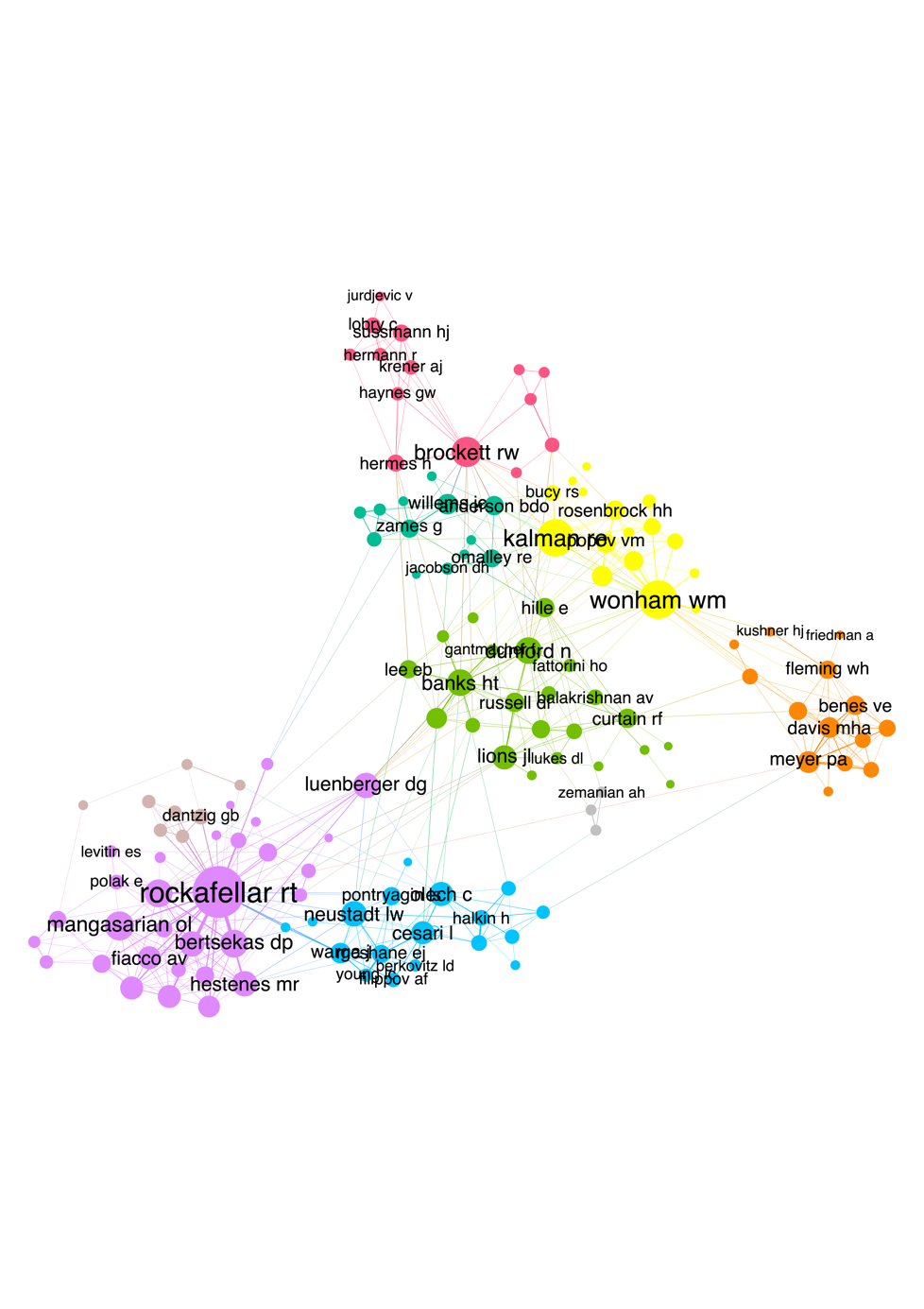
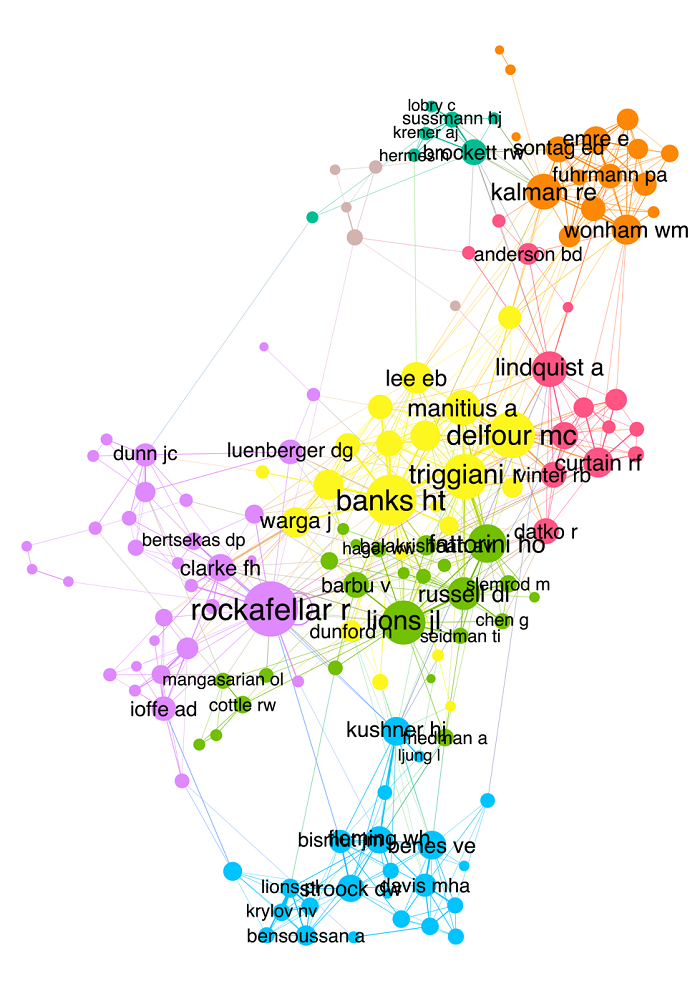
The realization by several control theorists at the end of the 1960s that geometric methods could lead to relevant insights and could solve seemingly intractable problems encouraged them to become acquainted with these tools.
In our view, the real criterion for deciding whether or not a mathematical theory A has significant applications to a research area B is whether, using A, questions about B can be answered that make sense before A is brought in, but cannot be answered without A (p. 517).
The above citation was written in the mid-1980s, when the community of geometric control theory was still in search for recognition and can therefore be interpreted as an attempt to legitimize the existence of this community. There exist attested cues of the diffuse institutionalization of geometric control theory by the mid-1980s, through textbooks (e.g.,
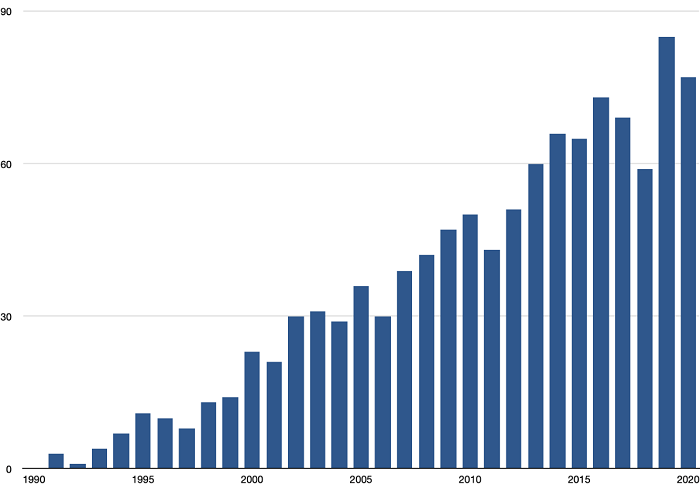
The emergence of geometric control theory at the beginning of the 1970s paralleled the publication of two simultaneous decisive contributions by control theorist
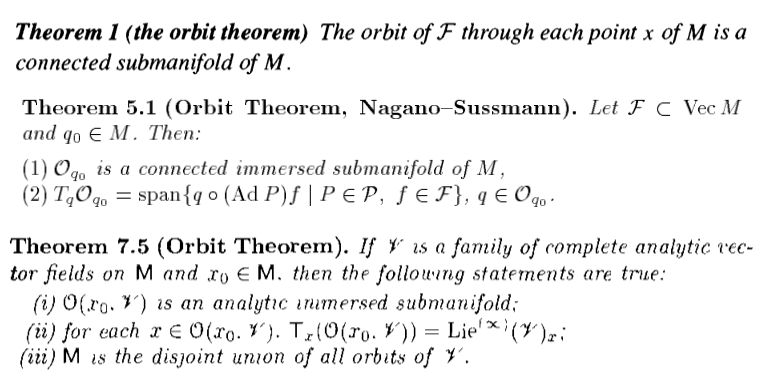
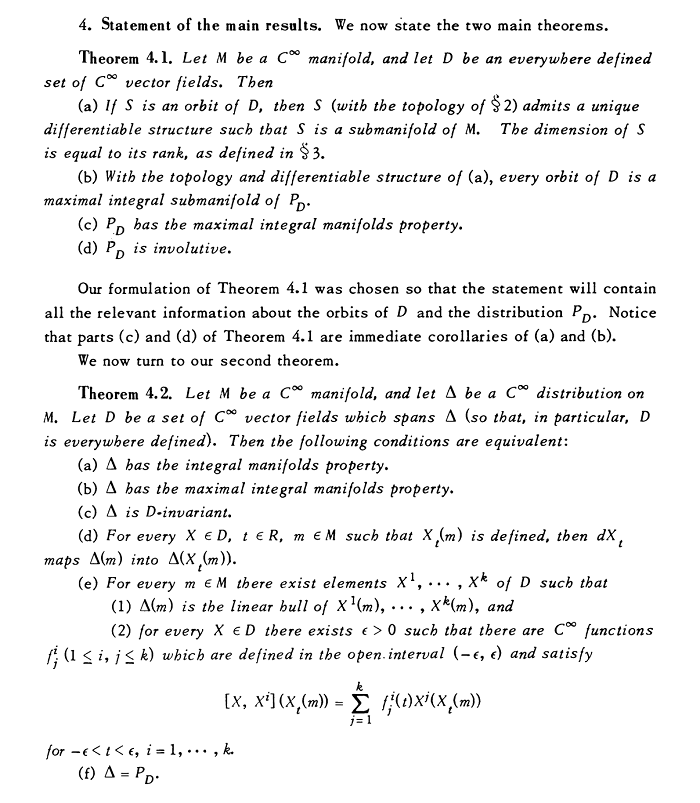
The second result proven by Stefan and Sussmann in their 1973-1974 articles (
A preliminary study of the mathematical literature citing the results of Stefan, Sussmann and Nagano, led to the hypothesis that citational usages were dependent on the citing community. In control theory, these authors seem to be cited mainly for the orbit theorem, while outside control theory, they were cited mainly for the generalization of Frobenius integrability theorem
Hector Sussmann was born in Buenos Aires in 1946. After earning a degree in mathematics in 1966, he went to the Courant Institute (NYU) to complete his doctorate in applied mathematics, which he defended in 1969. In his paper published in the Transactions of the AMS,
Simultaneously, Peter Stefan, then a Slovak refugee and a PhD student in differential geometry at the University of Warwick, proved the same results (

What do you cite for? Where do you cite from?
While Stefan’s and Sussmann’s contributions were produced for different objectives, they have also been received very differently within and outside the control theory community. In the citing corpus over the period 1993-2020, four main situations can be identified: 1) when the citing article refers to their papers for having proven the orbit theorem; 2) when the citing article refers to their papers for having proven the generalization of Frobenius integrability theorem; 3) for definitional purposes, such as for the definition of orbits or singular foliations; 4) as mere routine reference. The number of times Stefan or Sussmann were cited alone was also calculated. The proportion of each one of those categories is presented in Table 1.

Although Stefan and Sussmann simultaneously and independently proved similar results, there is no consensus on what their main contribution is, be it understood as the orbit theorem or as the generalization of Frobenius theorem. However, some variations in Table 1 may be explained by the different aspects favored by one author over the other. For example, the fact that Stefan is much more cited for definitional purposes certainly comes from the fact that the definition of singular foliations plays a prominent role in his paper. The authors are co-cited 108 times, which implies that 92 % of the time Stefan is co-cited with Sussmann. Usually, when they are cited in the same paper, they are cited for the same reason, in the same place of the text. The last column shows that Stefan is almost never cited alone (in only 8 % of the papers citing him), whereas Sussmann is cited alone two-third of the times. This might be explained by the fact that the references to Sussmann come mainly from the field of control theory, in which he is an important figure, while Stefan’s early death may have influenced his near disappearance from the citational landscape. To refine the analysis, the community to which each cited paper could belong was evaluated on the basis of bibliographical data (see Table 2 and 3).
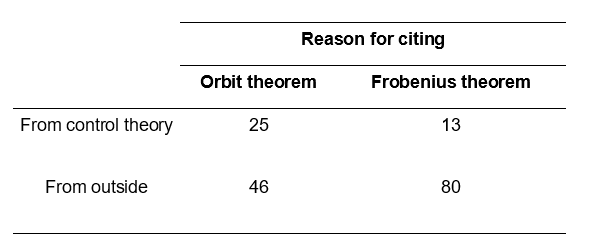
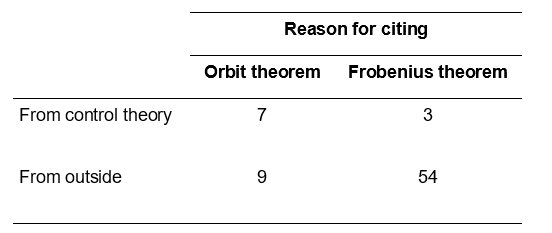
Stefan is disproportionately cited for the generalization of Frobenius integrability theorem outside control theory (Table 3). Sussmann is also widely cited for this reason, but he is also cited almost as much for the orbit theorem (Table 2). Notice that while in control theory he is cited twice as much for the latter than for the former, the situation is reversed outside control theory. These contingency tables support the preliminary observation
It might be objected that the differences in citational practices may be artificial because there are two distinct results in Stefan’s and Sussmann’s contributions (see Figure 6 and 7). This is not surprising because when they wrote their respective articles, both Stefan and Sussmann had different objectives and emphasized different aspects of their work. However, this justification is not convincing: indeed, it cannot explain the fact that mathematician
However, today his name is referred to in control theory as an important milestone in the conceptual foundation of the body of knowledge associated with geometric control, and he is sometimes presented as a precursor of the orbit theorem (along with Hermann). For example, in contemporary geometric control theory textbooks, the orbit theorem is alternatively attributed to Hermann and Nagano (
Table 4. Number of citations of
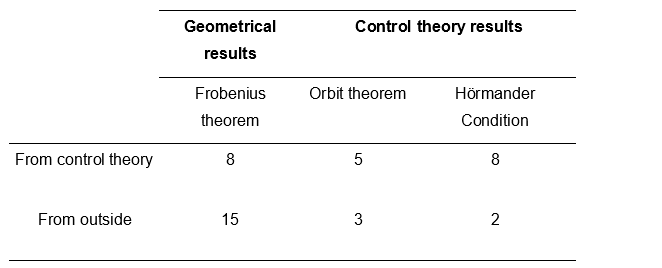
Outside control theory, Nagano has been overwhelmingly cited for his generalization of Frobenius integrability theorem. In contrast, in control theory, he has been as evenly cited for this result as for the Hörmander condition, and in a lesser extent for the orbit theorem. This correlation suggests that the reason for citing is highly dependent on the origin of the citation
Several actors agree on the sharp turn that the study of nonlinear control systems took in the 1970s, when the geometric perspective was introduced and became a defining element of this mathematical community (
Indeed, control theorist
The second part of the case study has then shown that these specific collective metamathematical views impact the production and the reception of mathematical contributions in control theory. The intention of Stefan to affiliate himself with the Frobenius theorem was explicit, whereas Sussmann chose to emphasize that the orbits of a control system form immersed submanifolds of the state space. This mathematical result, later recognized as a founding element of geometric control theory, has been subsequently labelled under the denomination ‘orbit theorem’. As the case study shows, this theorem – associated by control theorists to Stefan, Sussmann, Hermann and Nagano – seems not to be much mobilized outside of control theory. This situation can be explained by the fact that the results of Stefan and Sussmann sit at the border between control theory and differential geometry. The two communities then refer differently to these results because they are not interested in the same problems. A certain mathematical community may consider that the key point of a theorem lies not in the original intention of the author, but in the applications this community finds in it. Therefore, the original statement of a theorem may differ from the way it is invoked years later in each mathematical community, because some aspects of mathematical knowledge have stood out and shape what is considered as interesting or not.
A similar question had already been investigated in the 1960s by sociologist
Attributing a name to a mathematical statement is a performative and socially regularized act. It aims at pointing to a set of cognitive contents that go beyond the limits established by the original statement: “Theorems are in a sense just tags, labels for proofs, summaries of information, headlines of news, editorial devices” (
Therefore, the orbit theorem is much more than a mathematical statement: it carries collective metamathematical representations. Grasping this content could not have been possible without mobilizing the notion of mathematical communities. The case study demonstrates that mathematical knowledge is primarily a collective knowledge, and that mathematical practice is a collective practice. It is interwoven with socio-historical aspects in a way that could not be reduced to the oversimplified picture of the interaction between an agent – the mathematician – and an external socio-historical background. Rather, the interplay of the collective practices with which a mathematician has been acquainted in her professional life crystallizes in her unique individual practice. Thus, a philosophical inquiry about individual mathematical practices cannot be complete without acknowledging the role of mathematical communities and of their associated practices. Their importance is even more crucial in contemporary mathematics, which have been characterized by their increasing professionalization and internationalization since the Second World War.
A central aspect of mathematical practice consists of the metamathematical component, for it shapes not only the way mathematicians conduct their work, but also how they interact with exogenous mathematical knowledge. Then, grounding the philosophical notion of metamathematics in the sociological notion of mathematical community is a decisive movement to make the concept of collective practice operational. This makes it possible to highlight community-dependent aspects of mathematical production, which in turn demonstrates that institutionalized and settled mathematical knowledge is not unified but is susceptible to variations across communities. In time, it could be very informative to deepen these sociological considerations and to study the differentiated usages to which mathematical objects are subject in different communities. Thus, reinstating the collective dimension of mathematical work brings a much more dynamical perspective to the study of mathematical practices and their interplay. This illustrates how the use of sociology of science benefits the philosophy of mathematical practice.
My deepest thanks to Valeria Giardino for her advice and guidance during the preliminary phase of this work. I would like to thank the anonymous reviewers who have been solicited by the RAC and Trilogía, and especially to Emilien Schultz, without whom the manuscript in its present form would never have been attained. I would like to thank him for the relevance of his remarks and for the time and energy he took to correct the successive versions in their smallest details, despite the strict time constraints. This unfailing commitment to the journal and to me is even more important to underline since non-tenured researchers are already largely overloaded with work because of their institutionalized professional precariousness. Many thanks to Maëlys Tirehote-Corbin, Alexandre Vieira, Casey Blacker and Julien Larregue for their proofreading and their wise advice in the final phase of writing. The translation has partly relied on the software DeepL.